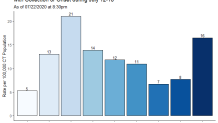A "substantial" number of new COVID-19 infections in Connecticut and other states in recent weeks are occurring in 18- to 29-year-olds, according to Governor Ned Lamont and Department of Public Health Acting Commissioner Deidre Gifford.
In a joint release between Lamont and Gifford, they warning of recent "outbreak clusters" among teens and young adults.
During the week of July 12-18, the largest infection rate by age group was among 20- to 29-year-olds at a rate of 21 per 100,000 people.

“We understand the importance of socializing and seeing friends after so many months of social distancing," Gifford said in a written statement. "We also know that teens and young adults want to do their part to protect their communities, especially the elderly and those at high risk of serious illness from the virus that causes COVID-19. There are ways to safely socialize. It’s always safest to gather outside, and keep six feet away from others. Always keep your mask with you."
Since mid-June, residents in their 20s have been the source of the highest infection rate of any group in the state, according to Department of Public Health data.
"This is a virus that can spread rapidly,” Lamont said in a statement. “A small cluster of cases can turn into hundreds of new infections within days. If you multiply that, we are looking at major impact to our ability to continue to reopen our economy or even send children back to school in September for in-person instruction."
Younger people have accounted for a smaller percentage of overall COVID-19 cases in the state. As of July 26, there were 48,983 cases of COVID-19 cases in Connecticut. About 12% of those cases are people who are 20-29 years old. However, that has changed. People in the same age group accounted for about 24% of new cases from July 5 to July 26.
Uncas Health District, covering 11 towns in Eastern Connecticut, is tracking the increase on a local level. Patrick McCormack, director of health, said that more than 40 percent of their new cases in the last week have been in 16-26-year-olds.
"There is some surprise when they get a phone call because I don't think they thought it could happen to them,” said McCormack.
McCormack said that his team realizes that quarantine has been tough on the younger age group. He said that it is possible to socialize safely if there is structure and people are wearing masks, more than 6 feet apart and gathering in small groups.
Instead, his team is seeing more large gatherings.
“What we are hearing is that they are coordinated events that are happening through social media and they are planning to get together as a group. May or may not be letting other family members know that they are doing this."
McCormack stressed that it is important to raise awareness. He said that parents can help by reminding their children to wear masks and maintain distance from other people
The Department of Public Health reports receiving anecdotal, unconfirmed information about youth sports teams traveling to states on the Connecticut travel advisory list.
Connecticut, New York and New Jersey have added Illinois, Kentucky, Minnesota, Washington, D.C. and Puerto Rico to the growing list of COVID-19 hotspots that require people to quarantine for two weeks or face a fine if they do not comply.
Gov. Ned Lamont, as well as the governors of New York and New Jersey, enacted a quarantine order for travelers at the end of June to help keep infection rates low in the region.
According to the governor's office, teams who travel to a state on the advisory list must cancel practices and competition for 14 days after returning to the state or risk a fine.
How Coronavirus Has Grown in Each State — in 1 Chart
This chart shows the cumulative number of cases per state by number of days since the 50th case.
Source: The COVID Tracking Project
Credit: Amy O’Kruk/NBC

